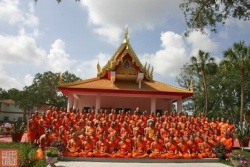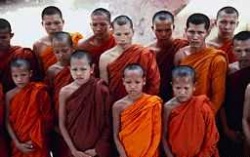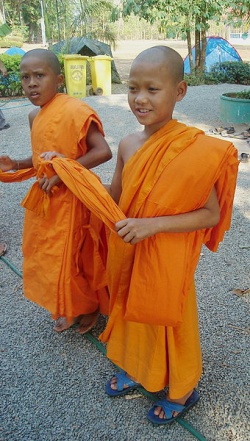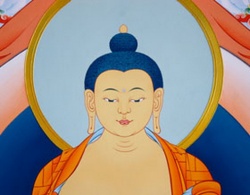Buddhism and Chakma Community by Venerable Soitiyo Lankar Vantey
Today, the large majority of the Chakmas are Buddhist by faith. The census figure do not indicated precisely the number of Chakma Buddhists in Tripura, Mizoram and Arunachal Pradesh and very little is known about the number of Chakmas in Myanmar and Bangladesh. However, the basis of information given by the Buddhist monks and our field study, it may estimate that 85% of Chakmas follows Buddhist faith.
It is again a matter of conjecture about the first adoption of Buddhism by the Chakmas. Rev. Dhirasekera thinks that the Chakmas converted to Buddhism by Indian Buddhist monks several centuries ago1. Taranatha, a Tibetan Buddhist scholar of the sixteenth century observes in his work “History of Buddhism in India” that the Tsagma (Chakma) were converted to Buddhism by the Indian Buddhist Missionaries. But this Buddhism was a form of Mahayana Buddhism which most probably seems to wane among them from the sixteenth century.
In order to revive Buddhism, an Arakenese Buddhist teacher of Hinayana school, Saramedha by name was invited to Chakma land by Kalindi Rani (1847-1873 A.D). Afterwards, she appointed him Sangharaja (head of monastery)2. It is said that before this, the Chakmas followed Buddhism as preached by a class of priest called Rari (pronounced as Rauli or Luri), a corrupted form of the word Rari3. As plied to Mahayanist priests.
It is therefore evident that formerly the Chakmas were followers of Mahayana Buddhism and from the time of Kalindi Rani, Hinayana Buddhism was introduced among the Chakmas. Thun Shew Khine a Burmese historian is of the opinion that the Chakmas were converted to Hinyana Buddhism by the Missionaries, who came from India after crossing the Arakan Hill Tracts4.
About the acceptance of Hinayana Buddhism their tradition says that there was a war between the Chakmas and the Arakenese, in which the former were defeated. The Chakmas came under Arakenese domination and came into direct influence of the Hinayana Buddhism. There were, of course occasional attempts of the Chakmas to re-assert independence from the Arakeneses but ended up in vain. Tales of their pathetic condition under the Arakenese are still recounted5. One such saying run thus:
Ghorot thele Maghe phai,
Zarot thele baghe hai.
(when we are in our house, we are caught by the Maghs (arakenese),
when we take shelter in the jungle, the tigers devoured us).
It only means that they were frequently attacked by Maghs whose religion the Chakmas accepted consequently. One tradition says that they are an offshoot of the Mughal soldiers with Magh women and it is from their mothers that they adopted Buddhism. Hutchinson thinks that the first known Chakma chief made terms with the Arakenese king and settled in the neighbourhood of the Naaf river to the south of the Chittagong District, where his people intermarried with the Arakenese and were gradually converted to Buddhism6. Lewin, however says that originally they were Hindus of good caste, when they settled in the Chittagong Hills they took wives from local people, who were Budhist7 and this resulted in their conversion to Buddhism. It is thus evident that the Chakmas received Hinayana Buddhism from the Arakenese.
Even today, the Chakmas look the Arakenese Buddhist Monks for Higher Religious practices. Before their coming to Mizoram, the Chakmas shared the Arakenese Mahamuni Mela and they themselves also held this Mela imitating the Arakenese. Till 1978, nearly all the Buddhist temples in Chakma villages in Mizoram had Arakenese monks who did not know the Chakma language, culture and traditions.
The Chakmas have no caste distinction, restriction in food and behaviors and do not detest others. Thus, Buddhism has been working as an instrument for social solidarity and inculcates a sense of communal harmony among the Chakmas.
Buddhist Literature: Along with religion Chakmas have borrowed the script from the arakenese8. Pali is their sacred language9 in which they have nearly all their canonical books10. Main Buddhist works of the Chakmas are:
- 1. Agar Tara
- 2. Sadwingiri Tara
- 3. Anija Tara
- 4. Arentama Tara
- 5. Singaltamal Tara
- 6. Sarakdan Tara
- 7. Dasparami Tara
- 8. Barakuruk Tara
- 9. Chhotokuruk Tara
- 10. Sripura Tara
- 11. Suradiza Tara
- 12. Fudumpulu Tara
- 13. Sahashphulu Tara
- 14. Swamiphulu Tara
- 15. Rakhemphulu Tara
- 16. Malem Tara
- 17. Trikuda Tara
- 18. Talikshastra Tara
- 19. Jiandoran Tara
- 20. Sabadiba Tara
- 21. Radhaphulu Tara
- 22. Aajina Tara
- 23. Saktasuktan Tara
- 24. Sakkya Tara
- 25. Fakiri Tara
Of these books, only the first one is written in their own dialect, while the rest are written in Pali. However, Pali is not understood by ordinary Chakmas.
The Agar Tara written in their dialect is a book, which contains many prayers to be chanted on various occasions such as on the death of a person, at the time of doing religious work at the marriage of a person, etc. One of their famous religious book is Gazener Lama (A psalm of Almighty) which is written in their dialect has passages like this:
Chaney surjiyey sodar bhey
Salaam dyang uddhysiyey chumit they.
Sarmukkhey salaam dyang pugedy
Pachimey salaam dyang bayedy
Uttarey salaam syang bayedy
Dakshiney salaam dyang denedy,
Salaam manei tapashi
Dharma sila tapashi.
(The sun and the moon are two brothers, Them I salute from the earth.
In front I salute the east, and on the back, the west.
I salute north, on the left, And on the right, the south.
Salutation is devotion to almighty And it is that makes a man hermit).
They are taught to avoid the two extremes, the easy life and strict Puritanism, but to follow the middle path and the noble eightfold path. The teachings of the Buddha directs man towards a transform existence, ‘a new being’, indicated by the term Nibana or Nirvana.
Their three jewels are:
And the four noble truths accepted by them are:
- The fact of suffering
- The cause of suffering
- The cessation of suffering
The noble eightfold paths, such as
- Right view
- Right resolve
- Right speech
- Right action
- Right livelihood
- Right Endeavour
- Right mindfulness
- Right rapture
Thus their Buddhistic teachings may be called “a selfless life”12.
The Tripitaka is their main religious book. Since it is in Pali language, its Bengali version Buddharanjika13 is a translation of Burmese Tripitaka. Like other Therevadins, the Buddhist Chakmas also accept the Buddha as a human being with realization of truth, after hard labour and attainment of enlightenment. The Chakmas follow the dictum, “One should obey one’s father and mother, One should respect the supreme value and sacredness of life. One should speak the truth. One should speak this virtue of Dhamma. In the same way pupils should honour their teachers and in families one should behave with fitting courtesy to relatives.
The Chakma Buddhists believe that the path of salvation is one of both physical and mental discipline and is not the end by itself. The meditation does not aim at control but at liberation; knowing the real through experience. The salvation goal is the result of one’s own effort.
The Buddhist Chakmas believe that soul is like butterfly, which during sleep can leave the body as its own will. A person dying of natural causes is reborn in some being appropriate to the amount of merit done by the deceased during his or her lifetime. Those who die of accident apparently do not move on in the chain of being but lingers on earth as a malevolent spirit or is reborn as animals. Such persons are buried as soon as possible with little ceremony. On the day of the funeral, a procession of monks, mourners and friends accompanies the coffin to the cemetery.
The monks recite the appropriate invocation in Pali language. The author experienced a burial service and found that the Chakmas themselves are afraid the spirit which may cause a sudden unnatural death to their family members. The monk, then, receives offerings and he pours water upon the ground to indicate that the deceased and all creatures are to share the merit of the gifts to the monks, the body is buried and the butterfly soul is told to be off.
They also believe in two places of the spirit world, one is a place of destruction and the other a place of peaceful rest. To know where the spirit of the dead approach they have two methods, the release of burning paper box and the flying of a long white cloth over the cremation. When the flying cloth is blown by the wind towards the south, where there is a place of eternal agony, the mourners wept bitterly. The body is marked with a charcoal believing that the dead when reborn in their family or of near relatives will have this mark. When a child is born within the family or among the relatives they look for mark in the new born baby to know who he or she is reborn.
Source
Author: Venerable Soitiyo Lankar Vantey
buddhismandaustralia.com



